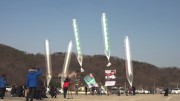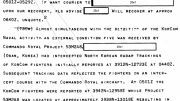A U.S. interceptor missile system designed to deter and defend against missiles from North Korea and other nations will take a step forward this week when the U.S. Missile Defense Agency kicks off work on environmental impact statements on four proposed sites.
On Wednesday, the MDA is expected to publish a notice informing residents in nearby neighborhoods of the start of a 60-day comment period that begins the process. The entire study is expected to take about two years and are intended to assess the environmental impact that the proposed missile defense bases will have to local land, water, air quality and other factors.
The sites are the Combined Training Center Fort Custer in Augusta, Michigan, Camp Ravenna Joint Military Training Center in Portage and Trumbull Counties, Ohio, Fort Drum Army Base in Fort Drum, New York, and the Center for Security Forces Detachment Kittery Survival, Evasion, Resistance, and Escape Facility (SERE East) in Redington Township, Maine.
The U.S. currently has two missile defense bases: Vandenberg Air Force Base in California and Fort Greely in Alaska.
In March 2013, U.S. Secretary of Defense Chuck Hagel announced plans to expand that shield with an additional 14 ground-based interceptors in Alaska, a new radar system in Japan to provide early warning of any missile launched by North Korea, and the environmental impact studies for additional sites in the U.S.
The plan was hatched in response to a string of missile and satellite launches undertaken by North Korea. Since it was announced, the country has continued in defiance of international opinion. In the last few weeks if conducted a series of short and medium-range test launches.
“Under the current proposed action, the deployment of the Continental United States Interceptor Site (CIS) would be as a contiguous Missile Defense Complex, similar to that found at Fort Greely, Alaska and would consist of an initial deployment of 20 Ground-based Interceptors (GBIs) with the ability to expand upward to 60 GBIs. The GBIs would not be fired from their deployment site except in the Nation’s defense and no test firing would be conducted at the CIS,” says a notice scheduled to be published in Wednesday’s Federal Register.
Here’s Hagel’s March 2013 announcement:
As he noted at the time, “While the Administration has not made any decision on whether to proceed with an additional site, conducting Environmental Impact Studies will shorten the timeline for construction should that decision be made.”





